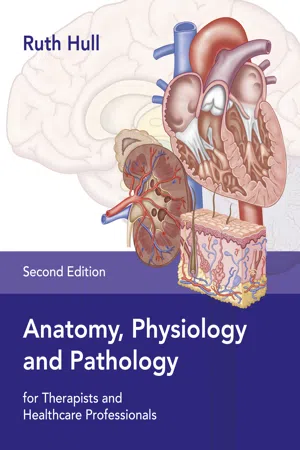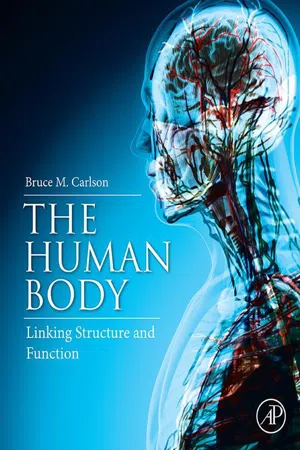Biological Sciences
Excretory System
The excretory system is responsible for removing waste and excess substances from the body, maintaining a balanced internal environment. Key organs include the kidneys, which filter blood and produce urine, and the bladder, which stores urine until it is excreted. Other components, such as the liver and lungs, also play roles in excretion by eliminating toxins and gases from the body.
Written by Perlego with AI-assistance
Related key terms
1 of 4
Related key terms
1 of 3
8 Key excerpts on "Excretory System"
- James Chambers, James Chambers(Authors)
- 2020(Publication Date)
- Omnigraphics(Publisher)
Understanding the Urinary SystemChapter 1 | Your Urinary System and How It WorksThe principal function of the urinary system is to maintain the volume and composition of body fluids within normal limits. One aspect of this function is to rid the body of waste products that accumulate as a result of cellular metabolism, and, because of this, it is sometimes referred to as the “Excretory System.”Although the urinary system has a major role in excretion, other organs contribute to the excretory function. The lungs in the respiratory system excrete some waste products, such as carbon dioxide and water. The skin is another excretory organ that rids the body of wastes through the sweat glands. The liver and intestines excrete bile pigments that result from the destruction of hemoglobin. The major task of excretion still belongs to the urinary system. If it fails the other organs cannot take over and compensate adequately.The urinary system maintains an appropriate fluid volume by regulating the amount of water that is excreted in the urine. Other aspects of its function include regulating the concentrations of various electrolytes in the body fluids and maintaining the normal pH of the blood.In addition to maintaining fluid homeostasis in the body, the urinary system controls red blood cell (RBC) production by secreting the hormone erythropoietin. The urinary system also plays a role in maintaining normal blood pressure by secreting the enzyme renin.Figure 1.1. Urinary SystemComponents of the Urinary SystemThe urinary system consists of the kidneys, ureters, urinary bladder, and urethra. The kidneys form the urine and account for the other functions attributed to the urinary system. The ureters carry the urine away from kidneys to the urinary bladder, which is a temporary reservoir for the urine. The urethra is a tubular structure that carries the urine from the urinary bladder to the outside.- eBook - ePub
- Zoe Davies(Author)
- 2017(Publication Date)
- Wiley-Blackwell(Publisher)
Chapter 14 The Urinary SystemThe urinary system is primarily involved in the extraction and removal of waste products from the blood. It filters the blood. In particular it is responsible for the removal of nitrogenous waste, and together with the digestive system it removes most of the waste products produced in the body, except gaseous carbon dioxide which is removed via the lungs. While removing these waste products, the urinary system is closely involved with the water balance, acid–base balance and salt balance. These processes are highly complicated and involve the influence of hormones. The products of excretion of the horse are shown in Figure 14.1 .Excretory products of the horse.Figure 14.1The urinary system is composed of two kidneys, two ureters, one bladder and the urethra (Figures 14.2 and 14.3 ). Each day approximately 1000–2000 litres of fluid are delivered to the kidneys of the horse. Since only approximately 5–15 litres of urine are excreted daily, the kidneys must remove most of the substances present in them. If the kidneys did not reabsorb fluid entering them, horses would lose their entire water and salt content in less than half a day.Position of the urinary organs.Figure 14.2Dorsal view of the urinary system.Figure 14.3Kidneys
The kidneys are a pair of reddish-brown organs and in the horse lie on either side of the body, approximately midway between the withers and the croup underneath the spine. The left kidney lies farther back towards the last rib, whereas the right kidney lies under the last three ribs. In this position they are well protected from external injury. The kidneys are situated outside the abdominal cavity but are bound to the upper wall of the abdomen by a layer of peritoneum which prevents the kidneys moving about as the horse moves. There are often large collections of fatty tissue around the kidneys which also helps to protect them. - eBook - ePub
- Ruth Hull(Author)
- 2021(Publication Date)
- Lotus Publishing(Publisher)
12 The Urinary System IntroductionTwo small organs, each no bigger than a large bar of soap and buried in fat, filter and clean the blood of toxins, and control its volume, composition, pH and pressure. In addition, these organs secrete essential hormones and can, in times of starvation, even manufacture glucose. These intricate organs are the kidneys, and each one is composed of around a million tiny filters that would stretch for more than 80 km if unwound and placed end to end (Barnard, 1981).The study of the urinary system is called urology , and in this chapter you will discover more about the invaluable role this system plays in your body.Student objectives By the end of this chapter you will be able to:• Describe the functions of the urinary system• Explain the organisation of the urinary tract• Describe the structure of the kidneys• Explain how urine is produced and how the volume, composition, pH and pressure of blood are regulated• Describe the common pathologies of the urinary system.Functions of the Urinary SystemWater is vital to every cell in our bodies and without it we would not survive. It circulates in blood plasma, and as it circulates it gathers toxins, wastes and any other substances that are not used by the cells. Blood, therefore, needs to be continually cleaned and its water content regulated, otherwise tissue cells would ‘drown’ in their own water and blood would become a river of circulating toxins and waste products.This vital role of cleaning and regulating blood is carried out by the two kidneys. They function in controlling the composition, volume and pressure of blood, and in doing this they help to maintain homeostasis of the entire body. The other organs of the urinary system (the ureters, bladder and urethra) transport, store and excrete urine.Infobox Anatomy and physiology in perspectiveThere are many accounts of people on hunger strikes, who refuse to eat as a form of non-violent protest. Mahatma Gandhi is one such example. Some strikers have been known to survive for many weeks if they have received fluids, but anyone who tries to refuse water cannot survive even a few days. Why is water so vital to our bodies? - eBook - ePub
- Britannica Educational Publishing, Kara Rogers(Authors)
- 2012(Publication Date)
- Britannica Educational Publishing(Publisher)
CHAPTER 3 THE PHYSIOLOGY OF URINARY EXCRETIONT he physiology of urinary excretion is in large part represented by the involved metabolic processes carried out by the kidneys. Despite the superficial complexity of urine production and excretion, at its most fundamental level, the physiology of these processes centres on basic mechanisms that govern the movement of substances across cellular membranes. Among these mechanisms are osmosis, the movement of molecules down their concentration gradient (from a region of high concentration to a region of low concentration), and active transport, the movement of molecules against their concentration gradient (from a region of low concentration to a region of high concentration). The combined effect of such processes is the filtration of wastes from the blood with the balance between water and solutes, such as sodium and chloride, in the blood maintained.Urine formation and excretion are influenced by multiple factors. For example, environmental factors directly affect the volume and composition of normal urine, which vary widely between individuals and from one day to the next. Such variation in healthy persons occurs primarily as a result of fluctuations in fluid intake and fluid loss.PRINCIPAL FEATURES OF URINE AND ITS EXCRETION
Urine is the liquid solution of metabolic wastes and certain other, often toxic, substances that the renal organs withdraw from the circulatory fluids and expel from the body. The composition of urine tends to mirror water needs. For example, freshwater animals usually excrete very dilute urine. Marine animals tend to combat water loss to their salty environment by excreting concentrated urine. Some marine species develop methods actively to expel salts. Terrestrial animals, depending on their habitat, usually retain water and secrete a highly concentrated urine.In humans, the formation of urine begins in the nephrons of the kidneys by filtration of blood plasma into the nephron. The fluid found within the nephron is essentially the same as blood plasma without the macromolecules (e.g., proteins). As the fluid passes along the nephron tube, water and useful plasma components such as amino acids, glucose, and other nutrients are reabsorbed into the bloodstream, leaving a concentrated solution of waste material called final, or bladder, urine. It consists of water, urea (from amino acid metabolism), inorganic salts, creatinine, ammonia, and pigmented products of blood breakdown, one of which (urochrome) gives urine its typically yellowish colour. In addition, any unusual substances for which there is no mechanism of reabsorption into the blood remain in the urine. The products of nucleic acid breakdown are present as uric acid in humans. - eBook - ePub
- Marc J. Klowden, Subba Reddy Palli(Authors)
- 2022(Publication Date)
- Academic Press(Publisher)
Chapter 8: Excretory Systems
Abstract
Byproducts of metabolism and end products of digestion are eliminated without significant water loss by the Malpighian tubules. The tubules are ion-driven, transporting the primary urine into their lumen and then to the hindgut and rectum, where some resorption occurs to form the secondary urine for elimination. Ammonia from protein ingestion is incorporated into various nontoxic molecules for elimination, including mostly uric acid, but urea and allantoin are also excretory products in some insects. Excretion is regulated hormonally with several factors determining rates of absorption by the tubules and release by the hindgut.Keywords
Diuretic hormones; Filter chamber; Malpighian tubules; Osmoregulation; Principal cells; Rectal pads; Storage excretionThe Excretory System maintains the internal environment of the insect by separating and eliminating metabolic wastes and other toxic substances from body compartments to allow normal metabolic processes to continue. Because these wastes are often dissolved in water, excretory processes are also closely associated with osmoregulation and the maintenance of water balance. Insects are typically 60%–75% water by wet weight but can range from 17% to 90% during the various life stages of particular species. Some insects can withstand dehydration to an incredible degree; several chironomid midges can still survive after losing up to 70%–90% of body water and survive temperature extremes of − 270°C to + 100°C once dehydrated to 3% of normal body water content. Water is an essential component of all living organisms and a molecule that almost all biological molecules must interact with. Insects, like all organisms, must carefully regulate their water content to maintain their physiological systems but have an amazing capacity for extreme tolerances. - eBook - ePub
Human Microanatomy
Cell Tissue and Organ Histology with Celebrity Medical Histories
- Stephen A. Stricker(Author)
- 2022(Publication Date)
- CRC Press(Publisher)
PART FOUR ORGAN HISTOLOGY—URINARY SYSTEM, REPRODUCTIVE SYSTEMS, AND SENSORY ORGANS- 16Urinary System
- 17Male Reproductive System
- 18Female Reproductive System
- 19Eyes
- 20Ears
Passage contains an image
CHAPTER 16Urinary SystemDOI: 10.1201/9780429353307-20PREVIEW
- 16.1Introduction to the urinary system
- 16.2Kidney anatomy: cortex vs. medulla, blood vessels, and nephron development
- 16.3Kidney histology: subregions of the kidney, renal pelvis of the ureter, and nephron compartments
- 16.4General morphology of a renal corpuscle (=Bowman's capsule + glomerulus + intervening urinary space)
- 16.5Renal corpuscle podocytes, filtration slits, and mesangial cells
- 16.6Nephron subtypes and medullary subregions
- 16.7Filtration, secretion, and resorption processes of excretion during urine formation and definitions of related terms—molarity vs. osmolarity and iso- vs. hyper- vs. hypotonic solutions
- 16.8Functional histology of post-corpuscle nephron regions during urine formation
- 16.9Histology of transporting and storage components: ureters, bladder, and urethra
- 16.10 The juxtaglomerular apparatus and renin-angiotensin system (RAS): a network for increasing blood pressure
- 16.11 Some disorders of the urinary system: kidney stones and glomerulonephritis
- 16.12 Summary and self-study questions
16.1INTRODUCTION TO THE URINARY SYSTEM
The urinary system comprises two kidneys, two ureters, a bladder, and a urethra. Each kidney connects via a ureter to the bladder, which in turn is drained exteriorly by the urethra (Figure 16.1a). The primary function of these organs is to filter blood plasma during the production of urine, thereby regulating water and electrolyte ion levels throughout the body. Urine also eliminates soluble waste via the process of excretion. Moreover, the urinary system removes water that could contribute to vascular volume and thereby raise blood pressure. Accordingly, the kidneys constitute a key part of the renin-angiotensin system (RAS) for modulating blood pressure. Along with their urine-related functions, the kidneys help maintain homeostasis by producing an active vitamin D metabolite, called calcitriol (1,25-dihydroxycholecalciferol), which increases intestinal uptake of calcium. In addition, low oxygen levels trigger interstitial kidney cells to secrete the hormone erythropoietin (Epo - eBook - ePub
- Marc J. Klowden(Author)
- 2013(Publication Date)
- Academic Press(Publisher)
Chapter 8Excretory Systems
The Excretory System maintains the internal environment of the insect by separating and eliminating metabolic wastes and other toxic substances from body compartments to allow normal metabolic processes to continue. Because these wastes are often dissolved in water, excretory processes are also closely associated with osmoregulation and the maintenance of water balance. Insects are typically 60–75% water by wet weight, but can range from 17% to 90% during the various life stages of particular species. Some insects can withstand dehydration to an incredible degree: there are several chironomid midges that can survive after losing up to 70–90% of their body water. As mentioned in a previous chapter, Hinton identified a chironomid that could survive temperature extremes of −270 to +100°C once dehydrated to 3% of normal body water content and afterwards rehydrated. Water is an essential component of all living organisms, and a molecule that almost all biological molecules must interact with. Like all organisms, insects must carefully regulate their water content to maintain their physiological systems, but have an amazing capacity for extreme tolerances.Insects are able to occupy a wide variety of terrestrial niches and deal effectively with issues of water balance largely because of two important adaptations: their impermeable exoskeleton and an Excretory System of considerable sophistication. As small terrestrial animals with a high ratio of surface area to body volume, insects lose water readily, and this loss must not be compounded by efforts to get rid of wastes. There are places to store water internally, such as the hemolymph, salivary glands, gut, and within the body cells in general. Many of these compartments can share the burden of water loss and transfer fluid from one compartment to another one that is more critical for survival. In preparation for metamorphosis, water stored in the gut of larval Manduca - eBook - ePub
The Human Body
Linking Structure and Function
- Bruce M. Carlson, Bruce M. Carlson(Authors)
- 2018(Publication Date)
- Academic Press(Publisher)
Chapter 13The Urinary System
Abstract
Formation of urine within the urinary system begins with the filtration of blood in the glomerulus of a nephron. The filtrate then moves to the proximal convoluted tubule, where resorption of glucose, amino acids, and many small molecules occurs. Permeability of the epithelium to water varies greatly, depending upon the region of the nephron. Much of the removal of water occurs in the collecting ducts, where antidiuretic hormone greatly influences the degree of removal. A countercurrent multiplier system, involving both the nephron and its accompanying microvasculature, is responsible for the buildup of an intense osmotic gradient from the cortical border of the medulla to the tips of the renal pyramids. Fully formed urine flows down the ureters into the urinary bladder, where it is stored until voiding. The structure of the bladder wall is highly adapted for both the storage and expression of urine.Keywords
Kidney; ureter; urinary bladder; urethra; nephron; glomerulus; proximal and distal convoluted tubules; loop of Henle; collecting ducts; filtration; resorption; cortex; medulla; countercurrent mechanism; antidiuretic hormone; urine; renin; mesangiumAt first glance, the purpose of the urinary system would seem to be quite straightforward—the production of urine . A major function of the urinary system is the removal of nitrogenous waste (mainly in the form of urea) and other metabolic by-products from the blood. However, like most body systems, other functions are intimately tied to the structures serving the formation and excretion of urine. The process of making urine is part of the body’s drive toward maintaining homeostasis —the maintenance of a stable internal environment. Homeostasis involves preserving an appropriate volume of blood and tissue fluids. It also encompasses maintaining a healthy balance of inorganic ions (e.g., Na+ , K+
Index pages curate the most relevant extracts from our library of academic textbooks. They’ve been created using an in-house natural language model (NLM), each adding context and meaning to key research topics.
Explore more topic indexes
Explore more topic indexes
1 of 6
Explore more topic indexes
1 of 4







